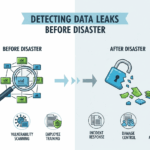The Rise of Shadow AI: A New Frontier of Risk
Artificial intelligence is rapidly transforming our world, but this technological leap forward comes with unseen dangers. Emerging threats, known as “Shadow AI,” are silently multiplying and posing a significant risk to businesses globally. A recent webinar hosted by The Hacker News, “Shadow AI Agents Exposed,” delved into this critical issue, offering invaluable insights for organizations striving to stay ahead of the curve.
Understanding Shadow AI and its Proliferation
The market for AI agents is booming, fueled by their ease of creation and deployment. These tools facilitate innovation and automation, but this same ease opens the door to “Shadow AI.” These are AI agents operating outside the purview of security teams, often unauthorized and unmanaged. As the webinar highlighted, Shadow AI agents are multiplying faster than many organizations can effectively manage. This rapid expansion makes it challenging to track and control AI activities, creating significant vulnerabilities.
The Risks: Data Breaches and Beyond
The core problem with Shadow AI agents is the inherent risk they introduce. These agents can impersonate trusted users, potentially leading to data breaches and unauthorized access to sensitive information. Consider the possibility of a Shadow AI agent, disguised as a legitimate employee, accessing and exfiltrating confidential customer data. Furthermore, these agents may utilize non-human identities (NHIs), further complicating detection and control efforts. Data leakage is another significant concern, as agents may inadvertently or intentionally transfer sensitive data across previously secure boundaries. Experts at the “Shadow AI Agents Exposed” webinar emphasized that these are not futuristic threats; they are actively occurring in various enterprises right now. The potential for “infinite risk” requires immediate and decisive action.
Expert Insights and the Path Forward
The Hacker News webinar featured experts who dissected the most pressing risks in AI operations. They discussed what constitutes an AI agent, how NHIs fuel Shadow AI, and detailed detection methods like IP tracing and code-level analysis. Strategies for effective governance were also discussed. The consensus was clear: organizations must take proactive steps to enhance visibility and control. The experts stressed the importance of implementing robust security measures, including comprehensive monitoring, identity management, and strict access controls, to mitigate these risks.
The Strategic Imperative
The key takeaway is this: the rise of Shadow AI presents a clear and present danger. Data breaches, reputational damage, and regulatory non-compliance are just some of the potential consequences. Businesses that fail to address this threat risk losing control of their data and operations. The solution is not to halt AI adoption, but to manage it proactively. Organizations must embrace a strategy that includes continuous monitoring, comprehensive identity management, and strict access controls. Prepare yourself. If you don’t act now, Shadow AI could outpace your defenses, leaving your organization exposed.

